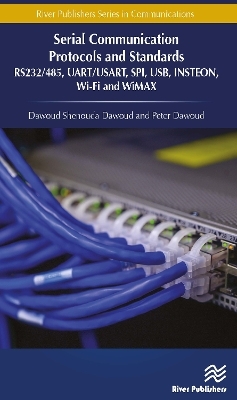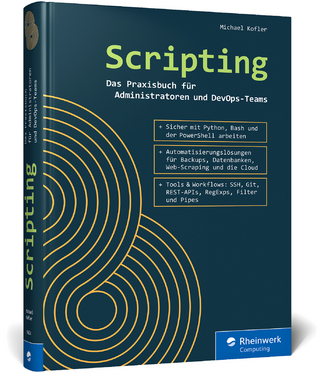
Serial Communication Protocols and Standards
Seiten
2020
River Publishers (Verlag)
978-87-7022-154-2 (ISBN)
River Publishers (Verlag)
978-87-7022-154-2 (ISBN)
Data communication standards are comprised of two components: The “protocol” and “Signal/data/port specifications for the devices involved”. The protocol describes the format of the message and the meaning of each part of the message. To connect any device to the bus, an external device must be used as an interface which will put the message in a form which fulfills all the electrical specifications of the port. These specifications are called the “Standard”. The most famous such serial communication standard is the RS-232.
In IT technology, Communication can be serial or parallel. Serial communication is used for transmitting data over long distances. It is much cheaper to run the single core cable needed for serial communication over a long distance than the multicore cables that would be needed for parallel communication. It is the same in wireless communication: Serial communication needs one channel while parallel needs multichannel. Serial Communication can also be classified in many other ways, for example synchronous and asynchronous; it can also be classified as simplex, duplex and half duplex.
Because of the wide spread of serial communication from home automation to sensor and controller networks, there is a need for a very large number of serial communication standards and protocols. These have been developed over recent decades and range from the simple to the highly complicated. This large number of protocols was necessary to guarantee the optimum performance for the targeted applications. It is important for communication engineers to have enough knowledge to match the right protocol and standard with the right application. The main aim of this book is to provide the reader with that knowledge
The book also provides the reader with detailed information about:- Serial Communication- Universal Asynchronous Receiver Transmitter (UART)- Universal Synchronous/Asynchronous Receiver Transmitter (USART - Serial Peripheral Interface (SPI) - eSPI- Universal Serial Bus (USB)- Wi-Fi- WiMax- Insteon
The details of each technology including specification, operation, security related matters, and many other topics are covered.
The book allocates three chapters to the main communication standards. These chapters cover everything related to the most famous standard RS-232 and all its variants. Other protocols such as: I2C, CAN, ZigBee, Z-Wave, Bluetooth, and others, are the subject of the authors separate book “Microcontroller and Smart Home Networks”.
In IT technology, Communication can be serial or parallel. Serial communication is used for transmitting data over long distances. It is much cheaper to run the single core cable needed for serial communication over a long distance than the multicore cables that would be needed for parallel communication. It is the same in wireless communication: Serial communication needs one channel while parallel needs multichannel. Serial Communication can also be classified in many other ways, for example synchronous and asynchronous; it can also be classified as simplex, duplex and half duplex.
Because of the wide spread of serial communication from home automation to sensor and controller networks, there is a need for a very large number of serial communication standards and protocols. These have been developed over recent decades and range from the simple to the highly complicated. This large number of protocols was necessary to guarantee the optimum performance for the targeted applications. It is important for communication engineers to have enough knowledge to match the right protocol and standard with the right application. The main aim of this book is to provide the reader with that knowledge
The book also provides the reader with detailed information about:- Serial Communication- Universal Asynchronous Receiver Transmitter (UART)- Universal Synchronous/Asynchronous Receiver Transmitter (USART - Serial Peripheral Interface (SPI) - eSPI- Universal Serial Bus (USB)- Wi-Fi- WiMax- Insteon
The details of each technology including specification, operation, security related matters, and many other topics are covered.
The book allocates three chapters to the main communication standards. These chapters cover everything related to the most famous standard RS-232 and all its variants. Other protocols such as: I2C, CAN, ZigBee, Z-Wave, Bluetooth, and others, are the subject of the authors separate book “Microcontroller and Smart Home Networks”.
Dawoud Shenouda Dawoud, Peter Dawoud
Serial Communication Protocols and Standards
| Erscheinungsdatum | 01.09.2020 |
|---|---|
| Verlagsort | Gistrup |
| Sprache | englisch |
| Maße | 156 x 234 mm |
| Gewicht | 760 g |
| Themenwelt | Mathematik / Informatik ► Informatik ► Netzwerke |
| Technik ► Elektrotechnik / Energietechnik | |
| Technik ► Nachrichtentechnik | |
| Technik ► Umwelttechnik / Biotechnologie | |
| ISBN-10 | 87-7022-154-5 / 8770221545 |
| ISBN-13 | 978-87-7022-154-2 / 9788770221542 |
| Zustand | Neuware |
| Haben Sie eine Frage zum Produkt? |
Mehr entdecken
aus dem Bereich
aus dem Bereich
das umfassende Handbuch für den Einstieg in die Netzwerktechnik
Buch | Hardcover (2023)
Rheinwerk (Verlag)
29,90 €
das Praxisbuch für Admins und DevOps-Teams
Buch | Hardcover (2023)
Rheinwerk (Verlag)
39,90 €


